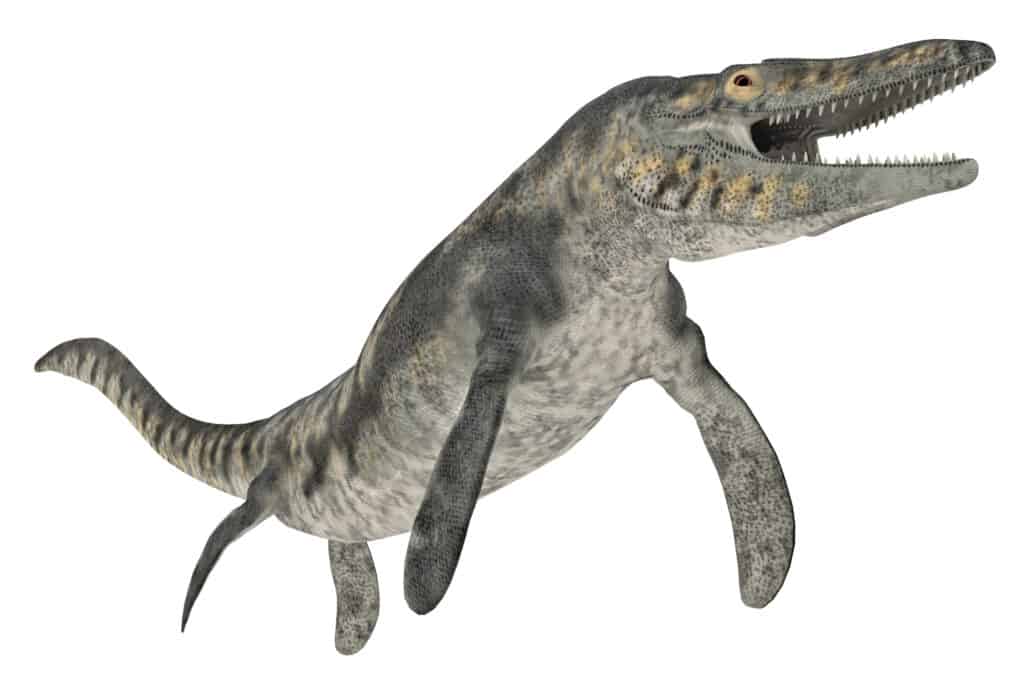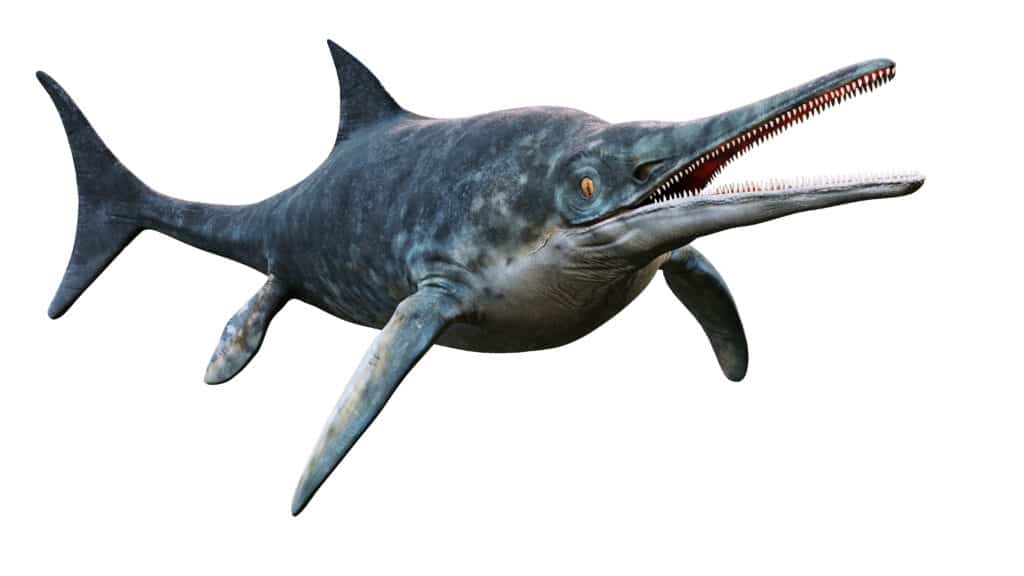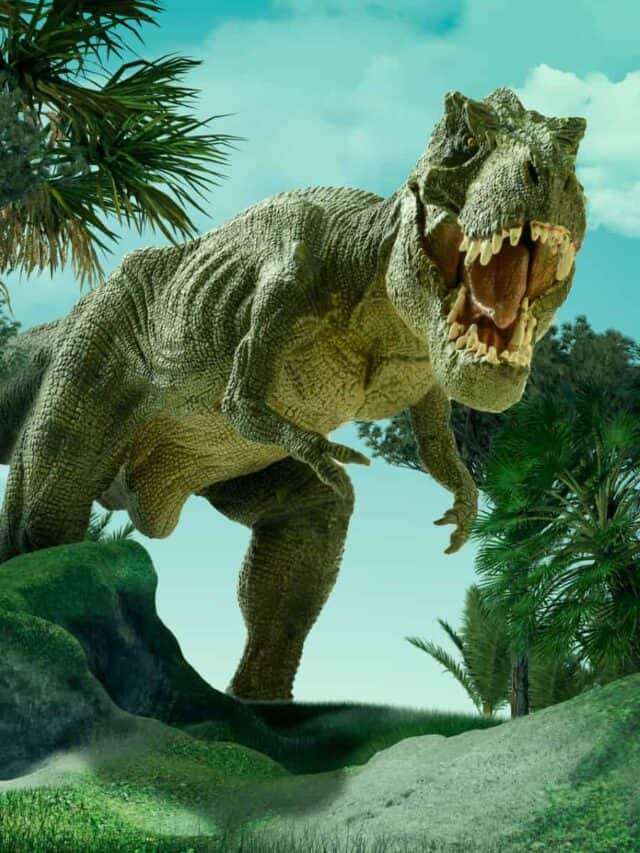The Mesozoic Era was the third of the three eras of evolution. These eras are periods of years in history that highlight evolutionary breakthroughs and events. The Mesozoic Era came after the Paleozoic Era, the ancient life era. It follows an eruption of life on earth which has evolved into what we have today.
The Mesozoic Era lasted for over 180 million years. It features many different-looking animals from what we have today. The continents as a whole also had different positions. During this era, many invertebrates, fishes, and plants evolved into modern forms. This era also features one of evolution’s apex predators, the dinosaurs.
The dinosaurs existed during the Jurassic period of this era. This era has three periods within it called; the Triassic, Jurassic, and Cretaceous periods. We will discuss the details of this period in this article. We will also discuss the animals, climate, and plants of this era.
What Is the Mesozoic Era?
The Mesozoic era is also famous as the middle life era. This era was between about 250 to 66 million years ago. During this period, life evolved and diversified. It gets its name from the Greek language, which means ‘Middle life.’ This period is also famous as the age of dinosaurs or the age of reptiles.
The Mesozoic era existed between the Paleozoic and the Cenozoic era. It follows the great extinction event of the Paleozoic era. It starts with a surplus of new species of creatures. These creatures include mammals, birds, and reptiles. The Mesozoic era featured apex marine predators like the Mosasaurs and Ichthyosaurs. Flowering plants also evolved during this period.
The era features the emergence of Pangea, which split during later periods. Pangea describes the supercontinent formed millions of years ago when the oceans gave way to more land. As the Triassic period ended, Pangea began to drift apart. It would later split to form the Gondwana and Laurasia regions.
Gondwana consisted of today’s South America and Africa. The Indian subcontinent was also part of Gondwana, Antarctica, and Australia. Laurasia consisted of today’s North America, Asia, and Europe. It was an era with no ice caps and a warm climate. Plants like cycads, conifers, and ferns evolved during this era.

Mosasaurs, now extinct, were large marine reptiles from the Mesozoic Era.
©iStock.com/MR1805
Periods of the Mesozoic Era
The Mesozoic era has three periods that detail the period certain evolutionary events occurred. These periods highlight specific times in evolution.
They include:
Triassic Period
The Triassic period ushered in the Mesozoic era. The Triassic period lasted between 251 to 200 million years ago. Three unique formations were discovered by Friedrich August von Alberti in the south of Germany. The formations were the Bunter, Muschelkalk, and Keuper. He grouped these formations into the Trias, which has now become the Triassic system.
The giant C-shaped Pangea emerged during this period. Pangea was a super-continent that emerged as the oceans gave way to more land. More land led to the rapid and diverse evolution of land animals. However, the super-continent started to split as soon as it emerged. More rift valleys formed between the African region of Gondwanaland and the North American region of Laurasia.
The plants during this period include smaller lycopods that survived the extinction and plants like Calamites that were like today’s bamboos. There were unique plants in different regions during the period. There were plants like ginkgos, Bennettitales, cycads, and ferns in the Laurasian region.
The Gondwanaland region had plants like Dicrodium and tree ferns. The tree ferns towered over typical trees in some parts during the period. Dicrodums were present in forests and dry woodlands. Archosaurs started to evolve during this period. Archosaurs are the family of animals that dinosaurs belong to.
The first real species of mammals evolved during this period. Giant turtles and crocodilians evolved in the waters during this period. Giant reptiles like Ichthyosaurs evolved later in this period. This animal was an apex predator in the oceans and it looked like dolphins. The first species of tortoises also evolved during this period.
Reptiles like Lystrosaurus evolved during the early Triassic period between 252 to 201 million years ago. Theriodintia is another reptile that evolved during this period.
This period has three stages within it. These stages highlight the seven epochs of this period. They are:
- Early Triassic stage: This stage lasted between 251 to 245 million years ago. The epochs in the early Triassic stage include; the Induan epoch and the Olenekian epoch.
- Middle Triassic stage: This stage lasted between 245 to 228 million years ago. The epochs in the middle Triassic stage include; the Anisian age and the Landinian age.
- Late Triassic stage: This stage lasted between 228 to 200 million years ago. The epochs in the late Triassic period include; the Carnian, Norian, and Rhaetian ages.

Giant reptiles like Ichthyosaurs evolved during the Triassic Period of the Mesozoic Era.
©Dotted Yeti/Shutterstock.com
Jurassic Period
The Jurassic age lasted between 200 to 146 million years ago. This period gets its name from its first fossil site, the Jura Mountains, between France and Switzerland. It follows an extinction event from the Triassic period, which scientists believe was caused by climate change and global warming.
Alexander von Humbolt described the formations as ‘Calcaire de Jura’, which means Jura Limestone. It informs the name ‘Terrains Jurassiques’ used later by Alexander Brongniart. During this period, Pangea disintegrated. The different parts of Pangea had different rotation rates. The difference in rotation rates caused rift valleys to form.
Sea levels were higher, and some regions of the continents were flooded. Gymnosperm plants were common in this period. The Jurassic age was the age of cycads as this plant was prevalent during this period. Cycadophyta is an example of a popular cycad of the time. Bennettitales also existed during this period.
Conifers remained the most popular large trees of the period. Ginkgos, Araucariaceae, Pinaceae, Taxaceae, and Cephalatoxaceae also existed in this period. Invertebrates like Corals, sponges, gastropods, bivalves, ammonoids, and bryozoa were viral in this period. Crinoids and Brachiopods are two invertebrates that evolved beyond the Jurassic period.
Sharks began to appear even in modern groups. This period features the diversity of one of the evolutions’ apex predators. The Ichthyosaurus ruled the oceans. There were Pterosaurs in the air which were usually of medium to small sizes. Dinosaurs were viral in different species, and they ruled the land.
The Mesozoic era was the age of dinosaurs, and this period saw the archosaurs dominate the earth. The abundant plant life provided plenty of food to herbivore dinosaurs. It allowed many species to flourish and the largest dinosaurs like Argentinosaurus to evolve. Other herbivore dinosaurs like the Argentinosaurus include Fabrosaurs, Hypsilophodontids, and Scutellosaurs.
The carnivorous dinosaurs of this period include Coelophysids, Ornitholestids, Ceratosauria, Compsognathids, and Dilophosaurids. This period had three stages within it that described its different epochs. They are:
- Early Jurassic stage: This stage lasted between 200 to 176 million years ago. The epochs in this stage are; the Hettangian, Sinemurian, Pliensbachian, and Toarcian ages.
- Middle Jurassic stage: This stage lasted between 176 to 161 million years ago. The epochs in this stage are; the Aalenian, Bajocian, Bathonian, and Callovian ages.
- Late Jurassic stage: This stage lasted between 161 to 146 million years ago. The epochs within this stage are; the Oxfordian, Kimmeridgian, and Tithonian ages.

Pangea was a super-continent that emerged during the Mesozoic Era.
©ManuMata/Shutterstock.com
Cretaceous Period
The name means ‘chalk bearing’ and is derived from the Latin word ‘Creta’, which means chalk. The Cretaceous period lasted between 146 to 66 million years ago. This period starts with the formation of northern Laurasia and southern Gondwanaland. These two subcontinents had already begun to drift apart into today’s positions. By the end of the period, most of today’s continents were standing alone.
The two subcontinents were split by the Tethys ocean. Flowering plants evolved and blossomed during this period. Archaefructus liaoningensis is the oldest found fossil of an angiosperm. It was discovered in China and dated to about 122 million years old.
Scientists suggest that insects like wasps and bees evolved during this period as a co-evolution for pollination. The oldest fossil discovered for bees was dated around 80 million years ago. More birds took to the air during this period. Confuciusornis and Iberomesornis are birds that existed during this period.
Some Jurassic species of dinosaurs went extinct before this period began. They include Diplodocus and Apatosaurus. Iguanodon, Ankylosaurus, and other ceratopsians evolved and lived till the end of this period. They existed with the Tyrannosaurus rex, an apex predator of this period. This period has four stages that highlight the epochs within it. They are:
- Early Cretaceous I: This stage lasted between 146 to 125 million years ago. The epochs within it are; the Berriastian, Valanginian, Hauterivian, and Barremian.
- Early Cretaceous II: This stage lasted between 125 to 99 million years ago. The epochs within it are; the Aptian and the Albian ages.
- Late Cretaceous I: the g This stage lasted between 99 to 83 million years ago. It is also called the High Cretaceous period. The epochs within it are; Cenomanian, Turonian, Coniacian, and Sanntonian ages.
- Late Cretaceous II: This stage lasted between 83 to 66 million years ago. It is also called the End Cretaceous period.

The Tyrannosaurus rex was an apex predator during the Cretaceous Period of the Mesozoic Era.
©iStock.com/para827
Conclusion
The Mesozoic era ended with a massive extinction event. It was caused by an asteroid impact about 66 million years ago. This Cretaceous-Paleogene extinction paved the way for today’s life forms to flourish. This era was an interesting one with one of history’s terrifying predators.
Up Next
Read about the major events, plants, and animals of some other prehistoric eras below:
The photo featured at the top of this post is © iStock.com/CoreyFord
Thank you for reading! Have some feedback for us? Contact the AZ Animals editorial team.






